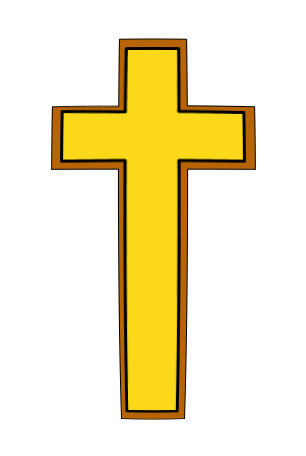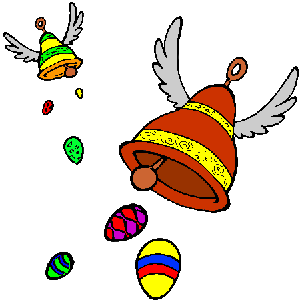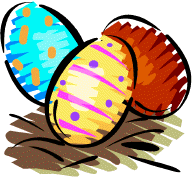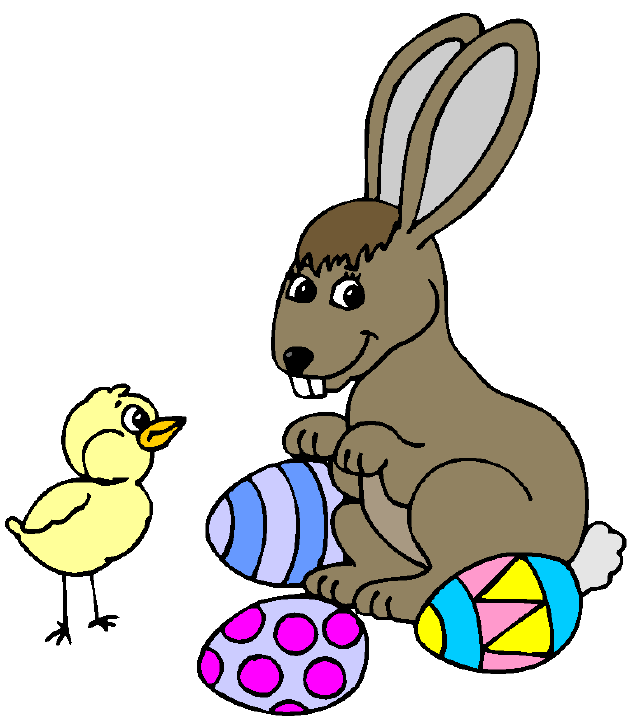top of page


La Fête de Pâques
written by Delphine, age 12 years

Bonjour! Je m'appelle Delphine!
1. The French word for Easter is Pâques. To wish someone a 'Happy Easter' you can say Joyeuses Pâques or Bonnes Pâques.
2. If a baby is born around Easter-time, then the name chosen for the baby might be Pascal, meaning 'belonging to Easter'. My little sister was born on Easter Day and that is why she is called Pascale!
3. Just before Easter, there is the fasting period of Lent - le Carême. Le Carême is a way of saying 'forty days'. The first day of Lent is Ash Wednesday - le Mercredi des Cendres. During le Carême people prepare for Holy Week - la Semaine Sainte.

4. The first day of la Semaine Sainte is Palm Sunday - le Dimanche des Rameaux. The word rameaux means 'branches'. This is the day when we remember the story of how Jésus rode into Jérusalem and the people greeted Him by laying palm leaves on the ground for Him to walk on.
On this day we carry little bunches of green branches - rameaux - to church so that the priest will bless them. The branches can be made from palm leaves, olive trees, laurel, rosemary. It all depends upon the plants that are easy to find in the area where you live.
In my family, Maman cuts little branches from the laurel bushes in our garden and we carry those to church.
There are some very artistic people who make wonderful braids and shapes with palm leaves. These are called les palmes tressées.
Palm Sunday is also known as Pâques Fleuries, meaning 'Easter in blossom', because of all the lovely plants and leaves.

5. During la Semaine Sainte, there are des processions in many towns. We have the processions in order to commemorate the death of Jésus and the events leading up to La Crucifixion. The most well-known processions take place on Good Friday - le Vendredi Saint. This is the day when the Crucifixion of Jesus is commemorated. A procession that takes place on this day is called le Chemin de Croix - the words mean 'the Way of the Cross.'
Lots of families go to church during Holy Week. In French, the church is l'église.
6. Le Jeudi Saint - Holy Thursday - is the day when we think about la Cène - the Last Supper of Jesus with His disciples.
On the evening of le Jeudi Saint something very strange and special happens! All the church bells in France fly away to Rome! C'est bizarre! These flying bells are known as les cloches volantes.

Question: How do the bells do this?
Réponse: The grown-ups tell the children that wings suddenly appear on the bells.
Question: Why do the bells do this?
Réponse: The grown-ups say that the bells fly to Rome to visit the Pope - le Pape. During their visit, they are blessed by le Pape and collect chocolate goodies to give to French children.
This means that all the church bells in France remain silent! No bells are heard because they have all flown away to Rome.

The bells fly back to France early in the morning of Easter Day!
This happy day is le Dimanche de Pâques. As the Easter bells - les cloches de Pâques - fly back, they drop chocolate goodies into the gardens of the French towns.

7. Some French children prepare nests in their gardens and houses. The nests - les nids - are for the Easter bunny who will fill them with chocolate eggs when he arrives during the night.
My little sister leaves out carrots for the bunny in case he is hungry.
He is called le lapin de Pâques or le lièvre de Pâques.


8. When we wake up on Easter Day - le Dimanche de Pâques - usually someone will call out - Les cloches sont passées! - meaning that the bells have visited.
The children have great fun finding the hidden goodies left in the nests by le lièvre de Pâques or scattered by les cloches de Pâques - the Easter bells! This egg hunt is called la chasse aux œufs.
Les cloches sonnent à nouveau! The church bells ring again because they have returned from Rome and are celebrating the Resurrection of Jesus! - la Résurrection de Jésus!
9. There is another traditional game that French children play at Easter. It is a game of 'catch' but instead of a ball we use raw eggs! It is called le lancer d'œufs.
We throw and catch - un œuf cru -a raw egg - between partners until someone drops it. That person will be le perdant - the loser and will be 'out' - éliminé.
Voici la règle du jeu:
Here are the rules of the game:
1. Les enfants forment deux rangées qui se font face.
The children stand in two lines facing each other.
2. Chaque enfant d'un côté lance un oeuf cru à son partenaire d'en face.
Each child on one side throws a raw egg to their partner opposite.
3. Les enfants qui cassent un œuf sont éliminés.
The children who break an egg are 'out.'
4. Le jeu se répète jusqu'à ce qu'il ne reste qu'un œuf intact.
The game is repeated until there is only one egg intact.
5. Ces deux partenaires gagnent la partie!
These two partners win the game!
6. L’œuf intact est considéré l'œuf vainqueur et il apporte la bonne fortune.
The intact egg is considered the winning egg and it brings good fortune.
10. There is something else that is very important in France at Easter.
It just so happens that April Fools Day, on 1st. April, occurs around the time of Easter.
On this day, French children play a trick on as many adults as possible by sticking paper fish onto the grown-ups' backs and running away.
Every time that we manage to trick a grown-up, we run away shouting - Poisson d'avril! - meaning 'April fish!'

11. In France, April fish are also an Easter symbol and that is why you will find chocolate fish in the shops too!

un poisson en chocolat
12. The shops where you buy the chocolate goodies are called les confiseries. You can also buy them in shops specialising in chocolate called les chocolateries. The traditional Easter chocolate shapes are: les cloches - bells, les œufs - the eggs, les lapins - bunnies.
My favourite type of shop is la chocolaterie. J'adore le chocolat.


une cloche, un œuf et un lapin en chocolat
13. Apart from all the chocolate, what else do we eat at Easter time?
On Good Friday - le Vendredi Saint - in my family we do not eat meat. Instead, it is the tradition to eat le poisson - fish. All my friends do the same thing too. We avoid eating meat on this day because we are thinking about la Crucifixion and les souffrances de Jésus sur la Croix - the suffering of Jesus on the Cross. A meat-free meal is called un repas maigre.
On Easter Day - le Dimanche de Pâques - traditionally we eat lamb: l'agneau. The special Easter dinner of lamb is called l'agneau pascal. Leg of lamb is le gigot d'agneau.
There are also lots of vegetables: les légumes. One of the most popular vegetables at Easter is asparagus - l'asperge.
14. Depending upon the area of France where you live, there are various traditional Easter cakes.

In the area called Vendée, there is la gâche de Pâques. It is a very rich bread mixture, like an oval-shaped brioche - containing bread flour, sugar, milk, yeast, butter and eggs.

In the area of Alsace, there is a sponge cake in the shape of a lamb. This cake is called le lamala.

On the French island of Corsica - la Corse - there is a cake in the shape of une couronne - a crown.
The cake is called le cacavellu. There are hard boiled eggs sitting on top and a pastry cross on top of each egg.


In the area of Charente there is an Easter triangular biscuit called la cornuelle. It has a hole in the middle.
There is also a pastry version, filled with cream.

In Provence there is a sweet Easter pie called la couve. The pastry decoration on the top symbolises chicks - des poussins - and eggs - des œufs.
The whole pie represents a hen's nest - un nid de poule.
15. Le Lundi de Pâques, c'est l’occasion de faire un pique-nique en famille! - On Easter Monday, it is the time to have a picnic with your family in a park or in the countryside. It is a lovely way in which to welcome le printemps - the spring.
Easter Monday is also known as la Pâquette - meaning 'the little Easter.' There is a tradition to eat omelette on this day.
In the town of Bessières, in the south of France, there is a festival on Easter Monday where a giant omelette is cooked. It is prepared with fifteen thousand eggs in a frying pan that is four metres wide. It is organised and cooked by a group of people called la confrérie de l'omelette géante.

16. Here is an Easter rhyme about hens laying eggs:
C'est la poule grise
Qui pond dans l'église.
C'est la poule noire
Qui pond dans le tiroir.
C'est la poule blanche
Qui pond sur la planche.
Here is an Easter joke about a hen laying eggs:
Question: La poule dit trois nombres quand elle pond un œuf. Lesquels?
Réponse: Sept. Un. Neuf.
(Sounds like 'C'est un oeuf!')
17. An Interesting Fact:
There are some very important relics to be found in the Cathedral of Notre Dame in Paris.
The cathedral is called la Cathédrale Notre-Dame de Paris.
These relics belong to the story of Easter and The Crucifixion of Jesus.
Les reliques sont:
The relics are:
1. La Sainte Couronne d'épines. The Holy Crown of Thorns. This is the crown of thorns worn by Jesus during His Crucifixion.
2. Le fragment du Bois de la Croix. This is a fragment of wood from The Holy Cross.
3. Le Clou. This relic is a nail from The Holy Cross.
Below is a photo of La Sainte Couronne d'épines. It is protected inside a round, glass reliquary.


Je vous souhaite de très joyeuses Pâques!
La Cathédrale Notre-Dame de Paris:
Sad news: In 2019, there was a devastating fire at the cathedral. We thank the brave firefighters and hope that the beautiful, ancient building with its important relics and art will be fully restored.


bottom of page